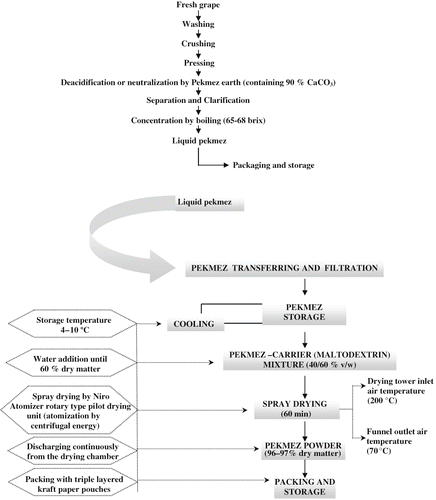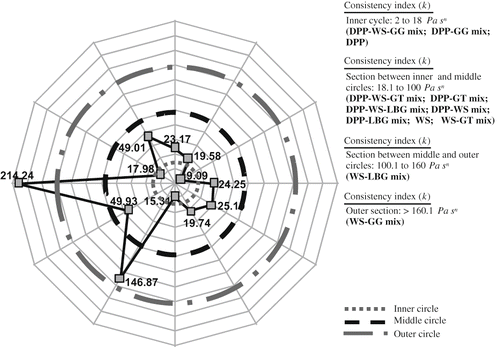Abstract
Pekmez, known also as grape molasses, was spray dried in the laboratory-type pilot drying unit to obtain pekmez powder. The flow characteristics of diluted pekmez powder (DPP), wheat starch (WS), and some hydrocolloids (locust bean gum, LBG; gum tragacanth, GT, and guar gum, GG) systems in double- or triple-mixed combinations were studied. The empirical power law model fitted the apparent viscosity-rotational speed data. DPP-gum and WS-gum mixed solutions exhibited a shear-thinning behaviour at 21°C with flow behaviour index (n) values of 0.88 ≤ n ≤ 0.94 and 0.17 ≤ n ≤ 0.32, respectively. WS-gum mixed solutions showed high shear-thinning behaviour with the highest consistency index (k = 49.93–214.24 Pa sn). However, DPP-WS and DPP-WS-gum mixed solutions at the same temperature exhibited the shear-thickening behaviour with flow behaviour index (n) values of 1.02 ≤ n ≤ 1.07.
INTRODUCTION
Pekmez, which has been produced for a long time in Turkey, is a traditional Turkish product produced from the juices of fruits such as grape, watermelon, prune, mulberry, carob, harnup and sugar beet. It is produced by concentrating juice up to a minimum of 70–80% total soluble solid content.[Citation1] Pekmez is a very nutritious food and a good energy and carbohydrate source, and therefore it is a very important product in human nutrition.[Citation2] However, prolonged storage of pekmez causes problems related with some quality characteristics. Hydroxymethyl furfural (HMF) development is one of the most significant problems occurring during the pekmez storage. Tosun and Ustun[Citation3] reported that HMF content of pekmez increased during prolonged storage period. In addition, the colour of pekmez darkens during this period, because of maillard reaction. When excessive maillard browning is undesirable in food systems, it can be inhibited by drying process in which the moisture is decreased to very low levels.[Citation4] Storage of pekmez as a dried form may be one of the useful ways to inhibit or delay excessive maillard browning, consequently decrease HMF development during the storage period. Another purpose of drying is to extend the shelf-life by reducing water content. Spray drying is ideal for heat-sensitive products such as maltodextrin, soup mixes and sugar-based foods. However, pekmez powder production by spray-drying technology is highly new and may not be applied. shows a flow diagram of pekmez powder processing operation. Pekmez powder is produced from pekmez by using spray drying, which is the most widely used industrial technology involving particle formation and drying. Like other heat sensitive liquid foods, pekmez can also be dried by the spray-drying technology.
Hydrocolloids are water-soluble, high molecular weight polysaccharides showing a variety of functions in food systems, such as enhancing viscosity, creating gel-structures, formation of a film, control of crystallization, inhibition of syneresis, improving texture, encapsulation of flavours, and lengthening the physical stability.[Citation5,Citation6,Citation7,Citation8] Dairy products, canned foods, bakery products, beverages, sauces, soups, and other processed foodstuffs are the products in which these functional ingredients are widely added to improve textural characteristics, flavour, and shelf life.[Citation9] Starch is the thickening and gelling agent most widely used in food industry. Starch is extensively used as thickening agent in sweets, sauces, custards and desserts. In spite of this extensive use, processing of starch is not entirely put forward and many parameters are known to be involved with its flow properties.[Citation10] In addition to its botanical origin, many other parameters such as presence of some components (sugars, hydrocolloids) and also thermal treatment (heating temperature, heating rate, shearing conditions) may affect its rheological characteristics.[Citation11]
Each hydrocolloid has its own particular properties, related to the chemical groups in the macromolecule and its spatial structure; however, the combined use of hydrocolloids can provide further functionality, which ranges from the single synergetic effect (increase in viscosity at a smaller relative dose) to the appearance of new properties (gelling without syneresis, resistance to low pH values, etc.).[Citation12] In this regard, starch and some hydrocolloids are often used together in food systems to provide further advantages; such as proper texture, controlling moisture and water mobility, improving overall product quality and/or stability, reducing costs, and/or facilitating processing.[Citation13] It is, therefore, important to understand interactions between starches and food gums that are critical to the functionalities they grant to food products.[Citation14] Changes in apparent viscosity can be used to study interactions between starches and gums.[Citation13]
The quality of food powders based on a variety of properties, such as the final moisture content, insolubility index and rheological properties is of primary importance to engineering applications. The rheological properties of dried and fluid food, therefore, should be carefully taken into account for designing and modeling purposes.[Citation15,Citation16] Moreover, the rheology is critically important for products like mixed solutions including gum and starch together in which the rheological property is considered as an indicator of the product quality. Calculations in the process involving fluid flows such as pump sizing, extraction or filtration requires a knowledge of rheological data. Rheology of a product is, therefore, necessary for the analysis of flow conditions in various food processes.[Citation16,Citation17]
There is much research about the rheological properties of pekmez,[Citation1,Citation18,Citation19,Citation20,Citation21] some starches,[Citation22,Citation23] and some starch-gum mixtures,[Citation13,Citation24] where a shear-thinning flow behaviour was generally observed; but the shear-thickening behaviour was rarely encountered. However, there is no published data informing flow and sensory properties of the diluted pekmez powder-wheat starch-gum systems in double- or triple-mixed combinations. Therefore, the purpose of this study was to characterize these properties of DPP-WS-gum mixed solutions.
MATERIALS AND METHODS
Pekmez Powder Production and Preparation of the Solutions
To produce pekmez powder, pekmez produced from fresh grapes according to the traditional method was spray-dried by Niro Atomizer laboratory type pilot drying unit in the plant of ENKA Dairy and Food Products Co., Konya, TURKEY, as in the process flow scheme diagrammed in the . Pilot scale test was performed in Niro Atomizer pilot spray-drying unit with the capacity of 10 kg powder per hour. The sprays were produced by rotary (wheel) energy. Evaporation of moisture from the pekmez droplets and formation of particles were performed under controlled temperature and airflow conditions. Pilot experiment was carried out with the mixture of grape pekmez and maltodextrin as a carrier (40–60% v/w). Because fruit juices could not be spray dried in the drying unit without filler or carrier, maltodextrin which is frequently used as filler and carrier, was used for this purpose. Maltodextrin addition prevents pekmez from becoming thicker and more adhesive to the processing equipment due to maillard reaction, which may result in pumping problems. The drying step took 60 min. The temperature of inlet air was 200°C and outlet air temperature did not exceed 70°C. The air flow direction and particle trajectories were the same. Rotary atomizer was located in the center of the chamber roof. An air turbine drive operating from a sixbar compressed air source, supplied power to the atomizer wheel. A vaned atomizer wheel was used for non-abrasive feeds and an atomizer wheel with carbide bushings for atomizing abrasive feeds. Particles in the range 5–25 μm were produced in the spray drying operation. At the end of processing, the pekmez powder having 96–97% of dry matter was packed with triple layered kraft paper pouches and stored in this way until analyses. The hydrocolloids—e.g. locust bean gum: LBG (Ceratonia siliqua), gum tragacanth: GT (Astragallus gummifer), and guar gum: GG (Cyamopsis tetragonolabus)—were obtained from Incom Co., Mersin TURKEY.
illustrates the formulations of DPP and WS solutions and mixed solutions, e.g. control and main solutions. To prepare the main solutions, a gum, wheat starch, pekmez powder and distilled water were transferred into a blender jar after separately weighing and then dissolved in the distilled water under vigorous agitation for 2 min., which resulted in homogeneous solution with no indication of any undissolved solid particle. The main solutions were stirred with heated magnetic stirrer. Continuous stirring of each mixed solution mix was maintained until temperature of 95°C was reached, and then the samples were kept at 95°C for a period of 30 min without mixing to ensure complete gelatinization. The rate of heating was about 1.5°C/min. Then, samples were allowed to cool and left for stand in a cooler incubator overnight at 21°C before conducting the rheological tests. The same procedure was applied to prepare the control solutions, except for those not containing WS. The control solutions not containing WS were prepared without any heating application, however, remaining process was the same for these solutions.
Table 1 Formulation of the solutions
Physicochemical Analysis
Total and soluble dry matter, ash and pH values were determined according to the standard method of the AOAC.[Citation25] The pH was measured with a pH meter (pH 315i/SET WTW, Weilheim, Germany). Soluble dry matter was determined with an Abbe-Zeis refractometer at 21°C and expressed as ºBrix. Water activity measurements were performed with an AQUALAB apparatus (DECAGON Devices Inc., Model Series 3TE, USA). Pure water (1.000 ± 0.003%) was used as standard for equipment calibration. Colour measurement was performed using a Minolta Chroma Meter CR-400 (Minolta, Osaka, Japan). The L∗, a∗, and b∗ colour measurements were determined according to the CIELab colour space system, where L∗ corresponds to light/dark chromaticity (changing from 0 dark to 100 light), a∗ to green/red chromaticity (changing from -60 green to 60 red) and b∗ to blue/yellow chromaticity (changing from −60 blue to 60 yellow). The instrument was calibrated with a white reference tile (L∗ = 97.10, a∗ = −4.88, b∗ = 7.04) before the measurements. Colour measurements were made 4 times, 1 on the middle and 3 on the different parts of the solutions.
Flow Behaviour
The apparent viscosity of solutions was measured at 21°C using LAB LINE viscometer, Model No 4535 (LAB LINE INSTRUMENTS, Inc., MELROSE PARK, ILL., U.K.). Appropriate spindles were used to get all readings within the scale. Viscometer readings were recorded at five different rotational speeds (5, 10, 20, 50, 100 rpm). All data were taken after 30s in each sample. A 100 ml beaker was used for all measurements and the solution sample was added to just cover the immersion grooves on the spindle shafts. The temperature was kept constant at 21°C using a thermostatically controlled water bath. The flow curves, apparent viscosity vs. shear rate, of all solutions studied were plotted by increasing speed rate (0.08 to 1.67 s−1 ). The data were fitted to the well-known power law model [EquationEq. (1)] which is used extensively to describe the rheological properties of non-Newtonian liquids in theoretical analysis as well as in practical engineering applications.[Citation26] In this study, yield stress data was not given although the Herschel-Bulkley model was also tested and gave an appropriate fit with high R 2 values. The yield stress was near zero and sometimes negative, which had no real physical meaning in the engineering applications. Therefore, it could be concluded that another equation such as power law other than Herschel-Bulkley equation should be used to describe the flow properties of pekmez powder-gum mixture solutions. The flow behaviour index (n), consistency index (k) values and determination coefficients (r 2) were obtained by fitting the rotational speed versus apparent viscosity values to power law model and calculated by employing linear regression analysis.
where η is the apparent viscosity (mPa s); k (Pa sn ) is the consistency index; γ is the shear rate (s−1); and n (dimensionless) is flow behaviour index. For n < 1, the model is pseudoplastic (shear-thinning); n > 1, the model is dilatant (shear-thickening).
Sensory Evaluation
Sensory evaluation was carried out to compare the sensory properties of control (only DPP-WS mix, taken as a reference solution) and main solutions. Quantitative descriptive analysis (QDA) was used. Three samples per batch were examined by seven selected and trained panellists who were familiar with the product. Ages ranged from 28–58. All panellists were non-smokers. Instructions were given in full to panellists beforehand. The solutions were prepared one day before and stored in refrigerator. The samples were brought to room temperature before testing. The panellists cleansed their palates with water before rating each sample.They evaluated taste (extreme sugary), appearance, consistency, odour, mouth-solubility and overall acceptance attributes. These sensory scorings were measured with a scale of 1 to 10: where <6 was considered “poor”; 6 to 7 was “fair”; and 8 to 10 was “good.” Studying the flow properties of ternary mixtures (control solutions) was the main objective in this study. Among these solutions, the control solution (DPP-WS mix) was always taken as the reference with a score of 7. The reason why the DPP-WS mix was selected as a reference was to see the effect of addition of these gums on the sensory properties. Only those attributes whose variations were significantly perceived by the panellists were considered for the purpose of the study. The data from reference and main solutions were displayed graphically using a radar chart.
Statistical Analysis
The averages and standard deviations of solutions were calculated for physical and sensory parameters. The results were subjected to ANOVA [Citation27] and significant differences between means were further separated by Duncan's Multiple Range test using MsTATC.[Citation28]
RESULTS AND DISCUSSION
Physicochemical Characteristics
As shown in , diluted pekmez powder (DPP) produced from fresh grape contained similar total and soluble dry matter, ash content and pH value to those reported for mulberry and white grape pekmez.[Citation1,Citation20] L∗, a∗, and b∗ values of DPP were measured as 50.68, +4.44 and +10.19, respectively. A high redness (a∗) value is not desired because it occurs as a result of excessive caramelization of sugars. A low redness (a∗) and high brightness (L∗) values indicate a good quality pekmez parameters.[Citation29] In this study, DPP, which was regarded to be equivalent to pekmez showed high L∗ values and low a∗ values, being an indicative of good quality DPP product.
Table 2 The chemical and physical characteristics of DPP
shows the average aw and colour values of DPP and mixed solutions, e.g.; control (DPP-WS) and main (DPP-WS-LBG, DPP-WS-GT, DPP-WS-GG) solutions. The aw value of DPP solution was 0.852, which was higher (p < 0.01) than those of DPP-WS and main solutions. Gum and WS addition was thought to decrease aw values of the mixed solutions, as can be expected. The lightness (L∗) value of DPP solution was higher (p < 0.01) as compared to those of DPP-WS and main solutions, whereas redness (a∗) and yellowness (b∗) values showed a reverse trend in these solutions, indicating the lowest redness and yellowness values of DPP solution. This was expected because of heating process at 95°C during the preparation step of the solutions, excluding DPP solution prepared without heating. The colour of DPP-WS and main solutions darkened; consequently L∗ values decreased and a∗ and b∗ values increased parallel with possible progressing of maillard reaction during heating. Increasing temperatures increase this reaction rate and development of HMF in thermally processed fruit juice.[Citation4]
Table 3 The mean values for aw and colour properties of the solutions (n = 6)Footnote∗
Flow Properties
The apparent viscosity (AV) of the DPP, WS, and control solutions was graphically plotted in
Figure 2 Apparent viscosity values of DPP, WS and control solutions. DPP: Diluted pekmez powder; LBG: Locust bean gum; GT: Gum tragacanth; GG: Guar gum; WS: Wheat starch.
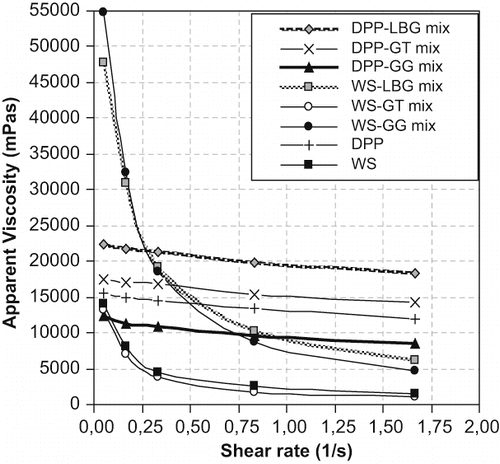
Figure 3 Apparent viscosity values of control (DPP-WS mix) and main (DPP-WS-Gum mixed) solutions. DPP: Diluted pekmez powder; WS: Wheat starch; LBG: Locust bean gum; GT: Gum tragacanth; GG: Guar gum.
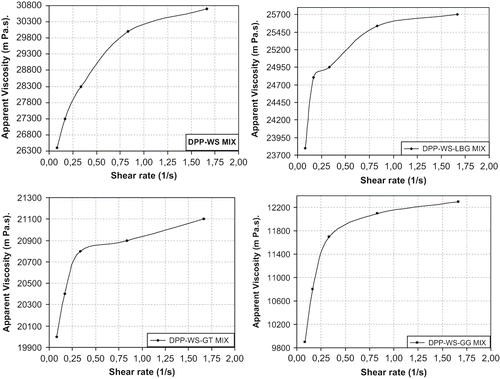
Table 4 Consistency index, flow behaviour index and apparent viscosity of DPP, WS, and mixed solutions (n = 6)Footnote a
Among the control solutions, only DPP-WS mixed solution showed the shear-thickening behaviour. The shear-thickening behaviour of this control solution, therefore, was thought to be a key indicator for finding the reason why the main solutions exhibited the shear-thickening behaviour. A possible explanation for this assumption is the interaction between DPP and WS, which could be a genuine reason why the shear-thickening behaviour was observed only in the solutions including both DPP and WS, e.g., DPP-WS and main solutions. This assumption was in accordance with the reports of Sikora, Mazurkiewicz, Tomasik and Pielichowski,[Citation30] who reported that when certain amounts of starch were blended with saturated aqueous solutions of fructose, glucose or sucrose, shear thickening, easily pourable semi solids were formed. The amount of starch necessary to cause this rheological effect also depended, at least in part, on the starch origin. Most of pekmez's carbohydrates were reported to be in the form of glucose and fructose and contain high amounts of reducing and total sugar (82.223, 83.809%, respectively) which is composed of approximately 100% invert sugar as glucose and fructose in almost equal quantities.[Citation1,Citation31,Citation32] Accordingly, glucose and fructose present in DPP was thought to interact with WS, which caused shear-thickening behaviour to emerge in the solutions containing both DPP and WS, concurrently, as also can be seen in and .
The WS-gum mixed solutions had highly shear-thinning behaviour with values of flow behaviour indexes (n) as low as 0.15–0.32 (). The smaller the n values the greater the departure from Newtonian behaviour. illustrates the magnitudes of consistency index (k) values of all solutions obtained by power law model. As can be seen in this figure, the k values of WS-gum mixed solutions were much more pronounced than those of DPP-gum and DPP-WS solutions, which was in agreement with information of Baird and Pettitt,[Citation33] who reported that hydrocolloid increased the starch system viscosity. The highest k value (214.24 Pa sn ) was found in the WS-GG solution, followed by those (146.87 Pa sn and 49.93 Pa sn ) of WS-LBG and WS-GT solutions, respectively. The higher k values of the WS-gum mixed solutions in comparison to other mixed solutions were attributed to the possible synergistic effects in the interactions between wheat amylopectin and gums when starches were cooked in gum solutions. These results were also in agreement with results of Shi and BeMiller,[Citation13] who determined the highest viscosity increase in wheat starch-guar gum mixed solutions as compared to that in the wheat starch-other gums mixed solutions. Among the WS-gum solutions, WS-GG solution was determined to be more strongly shear-thinning as compared to WS-LBG and WS-GT solutions. Guar gum is known to show high low-shear viscosity, but strongly shear-thinning and have much greater low-shear viscosity than that of locust bean gum, and also generally greater than that of other hydrocolloids. In this study, the similar trend was observed in the WS-GG solution that showed the most strongly shear-thinning behaviour. There was generally a negative relationship between the n and k values of the mixed solutions. Those with the high n values had the low k values,as seen in the .
Quantitative Descriptive Analysis
visually shows quantitative descriptive profiles for sensory attributes of DPP-WS, DPP-WS-LBG, DPP-WS-GT, and DPP-WS-GG solutions. The reference solution (DPP-WS mix) was taken as a reference with a score of 7. The radar chart illustrates that the main solutions took generally higher scores than the reference solution with respect to the sensory parameters. Gum addition increased scores given to the main solutions. There were differences (p < 0.01) between the solutions for quantitative descriptor of appearance, consistency, mouth-solubility and overall acceptance. Difference between reference solution and main solutions were more pronounced as revealed by Duncan test results. On the other hand, no significant difference was found between the solutions in respect of taste and odour parameters, which could be an indicative of the non-prevention the irksome (excessive sugary) taste by adding the gums, but no undesired effect of the gum addition on the odor of the reference solution. Mouth solubility and overall acceptance scores for DPP-WS-LBG solution were 8.1 and 8.1, respectively, and 8.3 and 7.9 (data not presented), respectively, for DPP-WS-GG solutions, which were higher than the scores given to the reference and DPP-WS-GT solutions. Gum mixed solutions took similar scores, which was found statistically insignificant, for appearance and consistency sensory parameters.
Figure 5 Quantitative descriptive (QDA) analysis profiles for sensory competitive comparison of reference (DPP-WS mix) and main (DPP-WS-Gum mix) solutions. Each ray, originating at the centre polygon (5.4 point) to the property label, the 1 to 10 linear response scale. Mean values (n = 14) for each property. Sensory score 1 to 10: where <6 is poor; 6 to 7 is fair; and 8 to 10 is good. DPP: Diluted pekmez powder; WS: Wheat starch; LBG: Locust bean gum; GT: Gum tragacanth; GG: Guar gum.
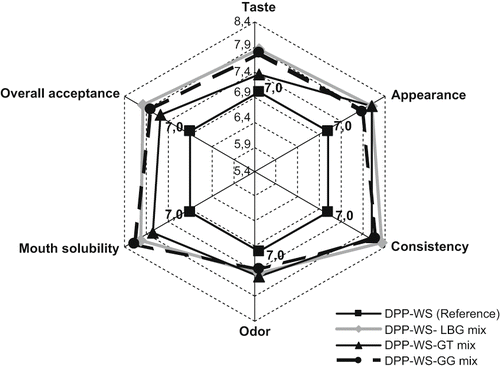
CONCLUSIONS
Pilot-scale experiment proved the possibility of production of pekmez powder diluted form (DPP) of which showed the comparable physicochemical and rheological characteristics to those reported for the pekmez in the literature. Therefore, process of pekmez powder production from pekmez by pilot type atomizer drying unit can be regarded as an acceptable production method, without modifying the fundamental physical-chemical parameters of pekmez in this study, by this way, processing and storage of pekmez powder may be an alternative way to the processing of pekmez in the liquid form. There are several advantages of the spray drying of foods. Among these advantages can be regarded as providing a unique drying process involving both particle formation and drying, controlling the obtained powder characteristics and maintaining the powder properties constant throughout a continuous operation. However, further investigation is needed to put forward the degree of spray drying to prevent further HMF and non-enzymatic browning product formation in DPP in addition to its physicochemical characteristics studied. The aw value of DPP was found to be 0.852, but the gum addition lowered the aw values of control and main solutions. The heating process applied on the mixed solutions in their preparation step decreased the brightness, but increased the redness of the solutions. Flow properties of the investigated solutions were adequately described by the power law model. DPP, WS, DPP-gum and WS-gum mixed solutions exhibited a shear-thinning behaviour; however, the mix of these components exhibited a shear-thickening behaviour when DPP and WS were simultaneously mixed in a solution, which caused the shear-thickening behaviour to emerge. The WS-gum solutions showed highly shear-thinning behaviour with the highest consistency index values. DPP-WS-gum mixed solutions generally received higher scores as compared to reference solution not containing gum. Among the main solutions, the liking of panellists was more prominent for DPP-WS-LBG and DPP-WS-GT mixed solutions. As a conclusion, main solutions, which can be described as the dilatant fluids, can be considered as acceptable products. These mixed solutions can be served as an alternative dessert and may be consumed with high liking with respect to the physical and sensory parameters studied.
REFERENCES
- Sengül , M. , Ertugay , M.F. and Sengül , M. 2005 . Rheological, Physical and Chemical Characteristics of Mulberry Pekmez . Food Control , 16 : 73 – 76 .
- Demirözü , B. , Sökmen , M. , Uçak , A. , Yılmaz , H. and Gülderen , S. 2002 . Variation of Copper, Iron, and Zinc Levels In Pekmez Products . Bulletin Environmental Contamination and Toxicology , 69 : 330 – 334 .
- Tosun , I. and Üstün , N. S. 2003 . Nonenzymic Browning During Storage of White Hard Grape Pekmez (Zile pekmezi) . Food Chemistry , 80 : 441 – 443 .
- Whistler , R.L. and Daniel , J.R. 1985 . “ Carbohydrates ” . In Food chemistry , 2nd , Edited by: Fennema , O.R. 69 – 137 . New York : Marcel Dekker .
- Dickinson , E. 2003 . Hydrocolloids At Interfaces and the Influence on The Properties of Dispersed Systems . Food Hydrocolloids , 17 : 25 – 39 .
- Dziezak , J.D. 1991 . A focus on gums. Food Technology . 45 : 116 – 132 .
- Garti , N. and Reichman , D. 1993 . Hydrocolloids as Food Emulsifiers and Stabilizers . Food Structure , 12 : 411 – 426 .
- Glicksman , M. 1991 . Hydrocolloids and Search for the ‘Oily grail . ’ Food Technology , 94 : 96 – 103 .
- Sahin , H. and Ozdemir , F. 2004 . Effect of Some Hydrocolloids on the Rheological Properties of Different Formulated Ketchups . Food Hydrocolloids , 18 : 1015 – 1022 .
- Abu-Jdayil , B. , Mohameed , H.A. and Eassa , A. 2004 . Rheology of Wheat Starch-Milk-Sugar Systems: Effect of Starch Concentration, Sugar Type and Concentration, and Milk Fat Content . Journal of Food Engineering , 64 : 207 – 212 .
- Thebaudin , J.Y. , Lefebvre , A.C. and Doublier , J.L. 1998 . Rheology of Starch Pastes from Starches of Different Origins: Applications to Starch-based Sauces . Lebensmittel-Wissenschaft und Technologie , 31 : 345 – 360 .
- Salvador , A. , Sanz , T. and Fiszman , S.M. 2001 . Rheological Properties of Xanthan gum-Gelatine Spray-dried Mixtures. Application in a custard-like formulation . European Food Research and Technology , 212 : 208 – 212 .
- Shi , X. and BeMiller , J.N. 2002 . Effects of Food Gums on Viscosities of Starch Suspensions During Pasting . Carbohydrate Polymers , 50 : 7 – 18 .
- Appleqvist , I.A.M. and Debet , M.R.M. 1997 . Starch-biopolymer Interactions-A Review . Food Reviews International , 13 : 163 – 224 .
- Straatsma , J. , Houwelingen , G.V. , Steenbergen , A.E. and Jong , P.D. 1999 . Spray Drying of Food Products: 1. Simulation model . Journal of Food Engineering , 42 : 67 – 72 .
- Kayacier , A. and Dogan , M. 2006 . Rheologica Properties of Some Gums-Salep Mixed Solutions . Journal of Food Engineering , 72 : 261 – 265 .
- Marcotte , M. , Hoshahili , A.R.T. and Ramaswamy , H.S. 2001 . Rheological Properties of Selected Hydrocolloids as a Function of Concentration and Temperature . Food Research International , 34 : 695 – 703 .
- Alpaslan , M. and Hayta , M. 2002 . Rheological and Sensory Properties of Pekmez (Grape molasses)/Tahin (sesame paste) Blends . Journal of Food Engineering , 54 : 89 – 93 .
- Kaya , A. and Belibağlı , K.B. 2002 . Rheology of Solid Gaziantep Pekmez . Journal of Food Engineering , 54 : 221 – 226 .
- Yoğurtçu , H. and Kamışlı , F. 2006 . Determination of Rheological Properties of Some Pekmez Samples in Turkey . Journal of Food Engineering , 77 : 1064 – 1068 .
- Sengül , M. , Ertugay , M.F. , Sengül , M and Yüksel , Y. 2007 . Rheological Characteristics of Carob Pekmez. International . Journal of Food Properties , 10 : 39 – 46 .
- Lagarrigue , S. and Alvarez , G. 2001 . The Rheology of Starch Dispersions at High Temperatures and High Shear Rates: A review . Journal of Food Engineering , 50 : 189 – 202 .
- Chen , C.R. and Ramaswamy , H.S. 1999 . Rheology of Tapioca Starch . Food Research International , 32 : 319 – 325 .
- Kim , C. and Yoo , B. 2006 . Rheological Properties of Rice Starch-xanthan Gum Mixtures . Journal of Food Engineering , 75 : 120 – 128 .
- Association of Official Analytical Chemists . 1984 . Official Methods of Analysis , 14th , Arlington, VA : AOAC .
- Barnes , H.A. , Hutton , J.F. and Walters , K. 1989 . An Introduction to Theology Edited by: Elsevier Applied Science . Vol. 11 AOAC.35 , New York
- MINITAB. Minitab Reference Manual, Release 7 . 2000 . 1 Minitab Inc., State Coll., PA
- Mstat , C. 1986 . Version 4.00 , EastLansing, MI : Michigan State Uni .
- Aksu , I. and Nas , S. 1996 . Dut Pekmezi Üretim Tekniği ve Çeşitli Fiziksel-Kimyasal Özellikleri . Gıda , 21 : 83 – 88 .
- Sikora , M. , Mazurkiewicz , J. , Tomasik , P. and Pielichowski , K. 1999 . Rheological Properties of Some Starch-Water-Sugar Systems . International Journal of Food Science and Technology , 34 : 371 – 383 .
- Karakaya , M. and Artık , N. 1990 . Zile Pekmezi Üretim Tekniği ve Bileşim Unsurlarının Belirlenmesi . Gıda , 15 : 151 – 154 .
- Artık , N. and Velioğlu , S. 1993 . Bazı Pekmez Örneklerinin Standarda Uygunluğunun Belirlenmesi Üzerine Araştırma . Standard , 32 : 51 – 54 .
- Baird , J.K. and Pettitt , D.J. 1991 . “ Biogums used in food and made by fermentation ” . In Biotechnology and Food Ingredients , Edited by: Goldberg , J.K. and Williams , R. 223 – 265 . New York : Marcel Decker Inc .
